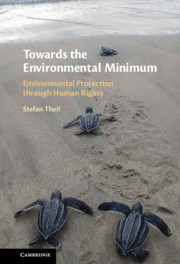Book contents
- Towards the Environmental Minimum
- Towards the Environmental Minimum
- Copyright page
- Dedication
- Contents
- Figures
- Acknowledgements
- Abbreviations
- 1 Introduction
- Part I Introducing the Environmental Minimum
- 2 Environmental Human Rights
- 3 The Environmental Minimum
- Part II The Environmental Minimum under the ECHR
- Part III Beyond the European Convention
- Part IV Beyond Human Rights Law
- Appendix: Data Methodology
- Bibliography
- Index
3 - The Environmental Minimum
from Part I - Introducing the Environmental Minimum
Published online by Cambridge University Press: 27 August 2021
- Towards the Environmental Minimum
- Towards the Environmental Minimum
- Copyright page
- Dedication
- Contents
- Figures
- Acknowledgements
- Abbreviations
- 1 Introduction
- Part I Introducing the Environmental Minimum
- 2 Environmental Human Rights
- 3 The Environmental Minimum
- Part II The Environmental Minimum under the ECHR
- Part III Beyond the European Convention
- Part IV Beyond Human Rights Law
- Appendix: Data Methodology
- Bibliography
- Index
Summary
The chapter introduces and defends the environmental minimum as a framework for the protections (and correlative duties) that environmental human rights require. It develops the guiding principles of the framework, modelled on the characteristics of human rights identified by James Nickel and as specified through the lens of environmental protection following Joseph Raz's interest theory of rights. The core prinicples of the environmental minimum that allow courts to make sense of environmental harm in the context of human rights protection regimes are: the specific risk principle, which acts as the trigger for the environmental minimum, requiring a specific risk to a recognised right arising from environmental harm; the minimum standards, which specify the baseline standard of review that courts ought to employ and are based on domestic and international legal norms, as well as established and emerging evidence that is generally accepted in the relevant scientific community; and finally the high priority characteristic, which guides the balancing of environmental protection with competing interests based on human rights.
Keywords
- Type
- Chapter
- Information
- Towards the Environmental MinimumEnvironmental Protection through Human Rights, pp. 59 - 118Publisher: Cambridge University PressPrint publication year: 2021

